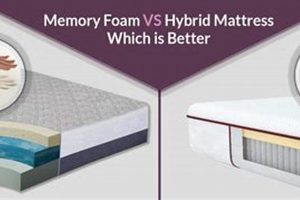The distinction between a sleeping surface that offers moderate support and one that provides substantial resistance is a key consideration when selecting bedding. The former typically allows for some contouring around the body, while the latter maintains a more rigid, unyielding plane. This difference in construction and feel caters to distinct preferences and physical needs.
This critical decision impacts spinal alignment, pressure point relief, and overall sleep quality. Historically, firmer options were often recommended for individuals with back issues, though modern understanding emphasizes the importance of individualized comfort. Selecting the appropriate support level contributes to long-term well-being and restorative rest.
Therefore, a thorough exploration of the characteristics, advantages, and potential drawbacks of each option is essential to ensure the chosen bedding aligns with individual sleep styles, body types, and any specific health considerations. The subsequent sections will delve into these factors, providing a comprehensive guide to making an informed purchase decision.
Considerations for Selecting a Mattress Support Level
Selecting the appropriate mattress firmness is crucial for optimizing sleep quality and physical well-being. The following tips provide guidance for navigating this important decision.
Tip 1: Assess Sleep Position: Back sleepers generally benefit from a moderately firm surface to maintain spinal alignment. Side sleepers often require more cushioning to alleviate pressure on hips and shoulders. Stomach sleepers may prefer a firmer option to prevent excessive sinking.
Tip 2: Account for Body Weight: Individuals with higher body weights may require a firmer mattress to ensure adequate support and prevent sagging. Lighter individuals might find a medium-firm option more comfortable, as it allows for better contouring.
Tip 3: Consider Existing Medical Conditions: Those with back pain should consult with a healthcare professional to determine the most suitable firmness level. A mattress that is too soft or too firm can exacerbate discomfort.
Tip 4: Evaluate Pressure Point Sensitivity: Individuals prone to pressure point pain, such as in the hips or shoulders, should prioritize a mattress that offers sufficient cushioning and pressure relief. Memory foam or latex materials are often beneficial.
Tip 5: Understand Material Properties: Different mattress materials offer varying degrees of firmness and support. Innerspring mattresses tend to be firmer, while memory foam and latex provide more contouring and pressure relief.
Tip 6: Test Before Purchasing: If possible, test the mattress in a store for at least 10-15 minutes in your typical sleeping position. This allows for a more accurate assessment of comfort and support.
Proper consideration of these factors will assist in selecting a mattress that promotes spinal alignment, pressure relief, and overall sleep quality. The ultimate goal is to find a mattress that provides personalized comfort and support.
The subsequent sections will address common misconceptions and summarize the key considerations for choosing between different support levels.
1. Spinal Alignment
Maintaining proper spinal alignment during sleep is crucial for minimizing back pain, promoting muscle relaxation, and facilitating overall musculoskeletal health. The selection of a mattress with appropriate support characteristics directly influences the degree to which the spine maintains its natural curvature throughout the night.
- Support and Posture
The primary role of a mattress in relation to spinal health is to provide adequate support to maintain the natural curves of the spine. A mattress that is too soft allows the body to sink, leading to spinal curvature and potential strain. Conversely, a mattress that is too firm may not conform to the body’s contours, placing excessive pressure on certain points. This support directly affects posture during sleep and, consequently, the well-being of the back and neck.
- Pressure Distribution
Spinal alignment is intrinsically linked to pressure distribution across the body. A mattress that promotes proper alignment ensures that body weight is evenly distributed, minimizing stress on specific areas such as the hips, shoulders, and lower back. Uneven pressure distribution can lead to discomfort, restless sleep, and potential exacerbation of existing musculoskeletal issues. The selection of an appropriate mattress can mitigate these effects.
- Muscle Relaxation
When the spine is properly aligned, the surrounding muscles are able to relax, reducing tension and promoting restful sleep. Conversely, if the spine is misaligned, muscles must work harder to compensate, leading to stiffness and potential pain. A mattress that supports the natural spinal curvature facilitates muscle relaxation, contributing to a more comfortable and restorative sleep experience.
- Long-Term Spinal Health
The long-term effects of mattress selection on spinal health should not be underestimated. Consistent sleeping on a mattress that does not provide adequate support can contribute to chronic back pain, disc problems, and other spinal issues. Investing in a mattress that prioritizes spinal alignment is an investment in long-term musculoskeletal well-being, preventing potential health problems and ensuring a higher quality of life.
Therefore, the correlation between spinal alignment and the selection of a mattresswhether offering moderate or substantial supportis a significant determinant of sleep quality and long-term spinal health. A careful assessment of individual needs and preferences is essential to making an informed decision that prioritizes proper spinal alignment.
2. Pressure Relief
Pressure relief is a critical factor in mattress selection, directly influencing sleep quality and overall comfort. The capacity of a sleep surface to alleviate concentrated stress points on the body, particularly the shoulders, hips, and knees, is paramount. The degree of firmness chosen has a significant impact on this capacity.
- Surface Conformity and Responsiveness
Surface conformity refers to the ability of a mattress to adapt to the body’s contours, distributing weight evenly. A mattress offering moderate support generally exhibits greater conformity than a firmer option. Materials like memory foam and latex excel in this area, molding to the body’s shape and reducing pressure buildup. A firmer surface, while providing ample support, may not conform as readily, potentially leading to increased pressure on prominent joints and bones.
- Material Density and Composition
The density and composition of mattress materials directly influence their pressure-relieving properties. Lower-density foams or innerspring systems with minimal padding offer limited pressure relief, potentially causing discomfort and restricting circulation. Conversely, high-density memory foam or latex effectively absorb and redistribute weight, minimizing pressure points. Material selection is therefore a crucial consideration when prioritizing pressure relief.
- Sleep Position and Pressure Point Distribution
Different sleep positions place varying degrees of pressure on specific areas of the body. Side sleepers, for instance, experience concentrated pressure on the shoulders and hips, necessitating a mattress with ample pressure relief in these zones. Back sleepers require support that evenly distributes weight to maintain spinal alignment, preventing pressure buildup in the lower back. Stomach sleepers may benefit from a firmer surface to prevent excessive sinking, which can exacerbate pressure on the neck and back. Understanding individual sleep position and its impact on pressure point distribution is essential for mattress selection.
- Impact on Circulation and Discomfort
Inadequate pressure relief can impede circulation, leading to numbness, tingling, and discomfort during sleep. Restricted blood flow can also contribute to restless sleep and morning stiffness. A mattress that effectively alleviates pressure points promotes healthy circulation, reducing the likelihood of these issues and contributing to a more restful and restorative sleep experience. Selecting a mattress with appropriate support and pressure-relieving properties is therefore crucial for promoting overall well-being.
In summary, the relationship between pressure relief and choice in mattresses, whether ones offering moderate or substantial support is multifaceted. By carefully considering surface conformity, material properties, sleep position, and potential impact on circulation, individuals can make informed decisions that prioritize pressure relief and promote optimal sleep quality.
3. Body Weight
Body weight exerts a considerable influence on the perceived comfort and support provided by different mattress firmness levels. Individual body mass dictates the degree of compression exerted upon the sleep surface, directly impacting spinal alignment and pressure distribution. Understanding this relationship is crucial for selecting a mattress that offers appropriate support and promotes optimal sleep quality.
- Compression and Support Threshold
Individuals with higher body weights will compress a mattress to a greater extent than those with lower body weights. This increased compression necessitates a firmer support core to prevent excessive sinking, which can misalign the spine and lead to discomfort. The support threshold, defined as the minimum level of resistance required to maintain proper spinal alignment, is directly proportional to body weight. Failure to meet this threshold results in inadequate support and potential musculoskeletal strain.
- Surface Contour and Pressure Distribution
A heavier individual will experience a greater degree of surface contouring on a given mattress. While moderate contouring can enhance pressure relief, excessive sinking can concentrate pressure points, particularly in the hips and shoulders. Firm mattresses, by resisting compression, distribute weight more evenly, reducing the likelihood of pressure buildup. The ideal surface contour strikes a balance between pressure relief and adequate support, a balance that is significantly influenced by body weight.
- Mattress Durability and Longevity
Higher body weights place greater stress on mattress materials, potentially accelerating wear and tear. Softer mattresses may exhibit premature sagging or indentation, compromising support and reducing longevity. Firmer mattresses, constructed with denser materials and robust support systems, are generally more resilient and better equipped to withstand the constant pressure exerted by heavier individuals. Selecting a durable mattress appropriate for body weight is essential for long-term comfort and support.
- Personal Preference and Subjective Comfort
While objective factors such as spinal alignment and pressure distribution are paramount, subjective comfort also plays a role in mattress selection. Some individuals, regardless of body weight, may prefer the feel of a softer or firmer mattress. However, it is crucial to ensure that personal preferences do not compromise adequate support and spinal alignment. Consulting with a sleep specialist or utilizing mattress trial periods can help individuals identify a mattress that balances comfort and support, taking body weight into consideration.
In conclusion, body weight acts as a critical determinant in the selection of a mattress with either moderate or substantial firmness. It influences compression rates, surface contouring, pressure distribution, mattress durability, and the overall perception of comfort. A thorough understanding of these interdependencies allows individuals to make informed decisions, ensuring optimal spinal support, pressure relief, and long-term sleep quality.
4. Sleep Position
Sleep position significantly dictates the ideal mattress firmness to maintain spinal alignment and minimize pressure points. The alignment of the spine, a primary determinant of sleep quality and musculoskeletal health, is directly influenced by the interaction between a person’s preferred sleep posture and the support characteristics of the sleep surface. Different sleep positions necessitate varying degrees of support and contouring to ensure proper spinal alignment throughout the night. For example, side sleepers typically require greater contouring to accommodate the curvature of the spine and alleviate pressure on the hips and shoulders, whereas stomach sleepers may benefit from a firmer surface to prevent excessive spinal curvature.
The importance of sleep position in determining mattress suitability becomes apparent when considering the biomechanics of each posture. Back sleepers generally experience the most even distribution of weight, necessitating moderate support to maintain the natural curvature of the spine. A surface that is too soft may allow the hips to sink, leading to lower back strain, while a surface that is too firm may not provide sufficient cushioning for the shoulders and buttocks. Conversely, side sleeping concentrates weight on a smaller surface area, requiring a mattress that conforms to the body’s contours to distribute pressure and prevent discomfort. The selection of an inappropriate firmness level can result in pressure point pain, restricted circulation, and disrupted sleep patterns. These considerations highlight the cause-and-effect relationship between sleep position, mattress firmness, and overall sleep quality.
In summary, the interconnection between sleep position and the appropriate choice of mattress firmness is paramount for promoting spinal health, pressure relief, and restorative sleep. Recognizing the distinct support needs associated with each sleep posture, whether back, side, or stomach, enables individuals to make informed decisions that align with their specific requirements. Selecting the correct mattress firmness mitigates musculoskeletal discomfort and facilitates a more restful and beneficial sleep experience, emphasizing the significance of sleep position as a critical component in the overall selection process.
5. Back Pain
The relationship between back pain and mattress firmness is a complex and often individualized consideration. The selection of a sleep surface offering moderate versus substantial support can significantly influence the presence and severity of back discomfort. This influence stems from the mattress’s impact on spinal alignment, pressure distribution, and muscle relaxation during sleep.
- Spinal Alignment and Support
A primary function of a mattress is to maintain the natural curvature of the spine. A surface that is too soft may allow the spine to sag, placing stress on the supporting muscles and ligaments. Conversely, a surface that is too firm may not conform to the body’s contours, leading to pressure points and restricted blood flow. Both scenarios can contribute to or exacerbate back pain. The ideal mattress provides sufficient support to prevent spinal misalignment while also offering enough cushioning to relieve pressure points. For instance, individuals with lordosis (an exaggerated inward curve of the lower back) may require a firmer mattress to prevent further spinal flexion. The ability of the mattress to maintain proper alignment is crucial.
- Pressure Distribution and Pain Mitigation
Uneven pressure distribution can concentrate stress on specific areas of the back, leading to discomfort and pain. A mattress that effectively distributes weight reduces the likelihood of pressure buildup on sensitive areas. Materials such as memory foam and latex can conform to the body’s shape, providing customized support and pressure relief. Individuals with arthritis or other conditions that cause joint pain may benefit from a mattress that minimizes pressure on affected areas. The even distribution of weight across the sleeping surface is a key factor in pain management.
- Muscle Relaxation and Recovery
A supportive and comfortable mattress promotes muscle relaxation, allowing the back muscles to recover and repair during sleep. A mattress that is too soft or too firm can force the muscles to work harder to maintain spinal stability, leading to stiffness and pain. The ability of the mattress to facilitate muscle relaxation is essential for reducing chronic back discomfort. For example, a mattress that provides adequate lumbar support can prevent the lower back muscles from contracting unnecessarily, reducing pain and promoting restorative sleep.
- Individualized Needs and Preferences
The optimal mattress firmness for back pain relief is highly individualized. Factors such as body weight, sleep position, and specific medical conditions can influence the ideal choice. While general recommendations exist, personal experimentation and consultation with a healthcare professional are often necessary to determine the most suitable option. A mattress that works well for one individual may not provide adequate support or pressure relief for another. Therefore, a personalized approach to mattress selection is essential for managing back pain effectively. The subjective experience of comfort and support must be considered alongside objective measures of spinal alignment and pressure distribution.
In conclusion, the selection between different mattress support levels and the mitigation of back pain are intricately linked. Spinal alignment, pressure distribution, muscle relaxation, and individualized needs all play critical roles in determining the most appropriate choice. While there is no one-size-fits-all solution, understanding these key factors can empower individuals to make informed decisions that promote spinal health and alleviate back discomfort, ultimately leading to improved sleep quality and overall well-being. This understanding is crucial for mitigating musculoskeletal health.
6. Material Density
Material density within a mattress directly correlates with its support characteristics and perceived firmness. A mattress core with higher density materials will generally offer greater resistance to compression, resulting in a firmer feel. Conversely, lower density materials provide less resistance, contributing to a softer, more yielding sleep surface. The interplay between material density and construction techniques determines whether a mattress is categorized as medium-firm or firm.
- Core Support and Sag Resistance
The density of the core materials, such as innerspring coils or foam layers, dictates the degree of support provided to the sleeper. Higher density coils or foams resist sagging and maintain spinal alignment more effectively, particularly for individuals with higher body weights. In a firm mattress, the core is typically constructed with high-density materials to ensure consistent support across the entire surface. The choice of core material density is paramount in the construction of a durable and supportive mattress.
- Surface Comfort Layers and Pressure Relief
While the core provides the primary support, the density of the surface comfort layers influences pressure relief. Lower density foams in the comfort layers allow for greater contouring around the body, reducing pressure points. A medium-firm mattress may incorporate lower density foams in the comfort layers to provide a balance of support and pressure relief. In contrast, a firm mattress may utilize higher density foams in the comfort layers to maintain a consistent level of support across the entire surface. The layering and density of comfort materials are therefore key to achieving the desired firmness level.
- Durability and Longevity
Higher density materials generally exhibit greater durability and resistance to compression over time. Mattresses constructed with higher density foams or reinforced innerspring systems are less prone to sagging and indentation, resulting in a longer lifespan. The selection of material density directly impacts the longevity of the mattress and its ability to maintain its intended support characteristics. Investing in a mattress with higher density materials can represent a cost-effective choice in the long run.
- Heat Retention and Airflow
Material density also affects heat retention and airflow within the mattress. Higher density foams tend to restrict airflow, potentially leading to increased heat buildup during sleep. Mattresses incorporating open-cell foams or ventilation channels can mitigate this effect. The breathability of the materials used, directly related to density, is a key factor in maintaining a comfortable sleep temperature. Consumers should consider the potential for heat retention when selecting a mattress with high-density components.
The interplay between core support, surface comfort, durability, and breathability, all influenced by material density, ultimately defines the characteristics of a sleep surface, determining whether it is categorized as medium-firm or firm. Therefore, material density serves as a key element when assessing the suitability of a mattress based on individual preferences and physical needs.
7. Longevity
The lifespan of a mattress, an element of economic and practical importance, is intrinsically linked to its firmness level. The support structure and materials used within mattresses of differing firmness experience varied stress levels over time, directly influencing their long-term performance and durability. A rigorous evaluation of material resilience under prolonged use reveals a connection between firmness and product lifespan. For instance, a mattress designed with high-density foams and robust coil systems typically demonstrates greater resistance to sagging and indentation than one constructed with lower-density materials. This characteristic contributes to extended usability and sustained support.
The impact of body weight and sleep position on mattress longevity is also significant. Individuals with higher body mass exert greater pressure on the sleep surface, potentially accelerating wear and tear. Firm mattresses, with their denser core materials, are often better suited to withstand this increased stress, maintaining their structural integrity for a longer period. Similarly, certain sleep positions, such as sleeping primarily on one side, can concentrate pressure on specific areas of the mattress, leading to localized compression over time. The choice between a mattress with moderate versus substantial firmness should consider these factors to optimize lifespan.
In conclusion, mattress longevity is a crucial factor influenced by firmness, construction materials, and usage patterns. Selecting a mattress based on firmness considerations should account for individual body weight, sleep position, and anticipated wear and tear. By prioritizing durable materials and appropriate support characteristics, consumers can maximize the lifespan of their mattress, ensuring long-term comfort and minimizing replacement costs. Choosing a suitable firmness level is therefore not only a matter of immediate comfort but also a practical investment in the long-term value of the sleep surface.
Frequently Asked Questions
The following addresses common inquiries regarding the selection between mattresses with moderate and substantial support, providing clarity on key considerations.
Question 1: What are the primary differences?
A mattress offering moderate support provides a balance between cushioning and support, often recommended for side sleepers. A firm mattress offers minimal give and is typically favored by back and stomach sleepers requiring more rigid support.
Question 2: Which is better for back pain?
The ideal support level varies. Some individuals with back pain find relief with a medium-firm mattress that contours to the body, while others prefer the stability of a firmer surface. Consultation with a medical professional is recommended.
Question 3: How does body weight influence the choice?
Individuals with higher body weights may require a firmer mattress to prevent excessive sinking and maintain spinal alignment. Lighter individuals may find a medium-firm option more comfortable.
Question 4: What role does sleep position play?
Side sleepers typically benefit from the contouring of a medium-firm mattress to alleviate pressure on hips and shoulders. Back and stomach sleepers often prefer the support of a firmer surface to prevent spinal misalignment.
Question 5: Do different materials affect the feel?
Yes. Memory foam tends to provide more contouring and pressure relief, making it suitable for medium-firm mattresses. Innerspring mattresses often provide a firmer feel due to their coil-based support system.
Question 6: How can I determine which is right for me?
Ideally, test mattresses in a store, spending at least 10-15 minutes on each in a typical sleep position. Consider body weight, sleep position, and any existing medical conditions.
Proper evaluation of these factors will aid in selecting a mattress that promotes optimal sleep quality and spinal health.
The subsequent section will summarize the key considerations discussed throughout this article.
Conclusion
The exploration of mattress medium firm vs firm reveals a multifaceted decision-making process. Spinal alignment, pressure relief, body weight, sleep position, and medical conditions are all critical factors. Material density influences support and durability, while longevity reflects the long-term value proposition. A thorough understanding of these interconnected elements is essential for selecting the optimal sleep surface.
Ultimately, the choice necessitates careful consideration of individual needs and preferences. While this analysis provides comprehensive insights, informed decision-making requires practical application of these principles. Prioritizing personalized comfort and support ensures a restorative sleep experience and long-term well-being.



![Choosing Innerspring vs Memory Foam Mattress? [Guide] Organic & Natural Mattress Buyer’s Guide: Non-Toxic Sleep Solutions Choosing Innerspring vs Memory Foam Mattress? [Guide] | Organic & Natural Mattress Buyer’s Guide: Non-Toxic Sleep Solutions](https://mattressworldpa.com/wp-content/uploads/2025/07/th-1100-300x200.jpg)



